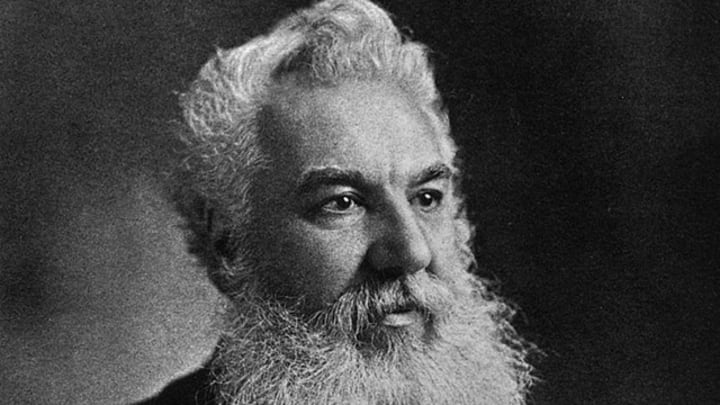SCIENTISTS (1847–1922); SCOTLAND
For most people, the name Alexander Graham Bell conjures up the man who helped invent the telephone in 1876. And while Bell was responsible for radically changing how the world communicates, there was far more to his life than just one invention, both good and bad. Take a look at some of the lesser-known facts about the inventor who made it possible for us to stay connected.
1. Alexander Graham Bell's inventions go beyond the telephone.

Alexander Graham Bell was born on March 3, 1847, in Edinburgh, Scotland, and from a young age, he was primed for a future in innovative thinking. His father and grandfather, after whom he was named, were experts in voice and elocution, and his mother, Eliza, was a talented pianist. As the family relocated to London, Canada, and the United States, Bell pursued solutions to everyday problems through his inventions. Among some of his more notable inventions:
- The telephone, which debuted in 1876 and was the result of Bell working in tandem with electrician Thomas Watson.
- At age 12, Bell developed a machine that could easily remove husks from wheat grain.
- Bell developed an early version of the metal detector called an induction balance, which was used in a failed attempt to find the bullet lodged in President James Garfield after he was shot by a man named Charles Guiteau in July 1881. (Garfield died 80 days after the shooting due to an infection from the wounds.) Bell would later improve upon the invention, and it would eventually be used to successfully detect bullets in soldiers during World War I.
- Bell’s “ice stove” was a precursor to modern air conditioning. At the height of the summer of 1911, Bell publicized the invention by cooling his office down to a chilly 61°F for an interview with The New York Times.
- With Casey Baldwin, Bell invented the hydrofoil, best described as a boat on skis. At high speed, the boat rose above the water, reducing drag. Their HD-4 unit managed to get up to 70.86 miles per hour in 1919.
- In 1881, Bell coped with his newborn son’s death from tuberculosis by inventing a metal vacuum jacket to help facilitate breathing. It was thought to be the first step toward developing the iron lung.
2. Alexander Graham Bell wasn’t the only person to pursue the idea of a telephone.

Because of his family’s history with voice and speech education—his mother was also deaf—Bell was always intrigued by ways of communicating via alternative means. His harmonic telegraph in 1871 could transmit multiple messages over a wire at once. Soon, Bell wanted to see if he could transmit a voice instead. With the help of investors and electrician Thomas Watson, he was successful in developing a receiver that turned electricity into sound. But other inventors like Antonio Meucci and Elisha Gray had similar ideas. In the end, Bell was the first to the patent office and the first to make a phone call—to Watson. He also ushered in the Bell Telephone Company in 1877. As a result, his is the name most closely identified with the discovery. Roughly 550 challenges to his telephone patent were ultimately unsuccessful.
3. Alexander Graham Bell invented more than one way to communicate.

While Alexander Graham Bell’s legacy will forever be tied to the telephone, he never stopped trying to devise ways to transmit information. His “photophone,” invented in concert with assistant Charles Sumner Tainter, could transmit sound via a beam of light. Bell used a selenium crystal and a mirror that vibrated in response to sound. Bell and Tainter had success sending a message 200 yards using this method in 1881. The achievement is thought to have anticipated the fiber-optic communication system we use today.
4. Alexander Graham Bell wasn’t necessarily the biggest fan of the telephone.

Despite Bell’s breakthrough, he was not one to indulge in its ease of communication. Reportedly, Bell refused to keep a telephone in his work study because he was afraid it would impact his productivity, according to History.com.
5. Alexander Graham Bell had a controversial interest in eugenics.

Given his work on behalf of the deaf community, Bell was curiously blithe about expressing an interest in eugenics, advocating for selective breeding that could potentially exclude diseases and disabilities. He also spoke out against immigration. In 1921, Bell was even named honorary president of the Second International Congress of Eugenics.
6. Alexander Graham Bell and Thomas Edison made each other better.

While Bell gets most of the credit for the telephone, it was fellow inventor Thomas Edison who modified the transmitter for it in 1877, which provided amplification and made the device easier to use. (Inventor Emile Berliner came up with a similar device around roughly the same time.) Likewise, Bell was able to improve on an invention of Edison’s. After Edison invented the phonograph in 1877, using tin foil as the recording medium, it was Bell who came up with the more practical wax recording cylinder nine years later.
7. Alexander Graham Bell’s death in 1922 was honored with a special tribute.

Alexander Graham Bell died on August 2, 1922, at age 75 as a result of complications from diabetes. On the day of his burial, all telephone service in the United States went silent for one minute as a tribute to just how important Bell’s contributions had been.
